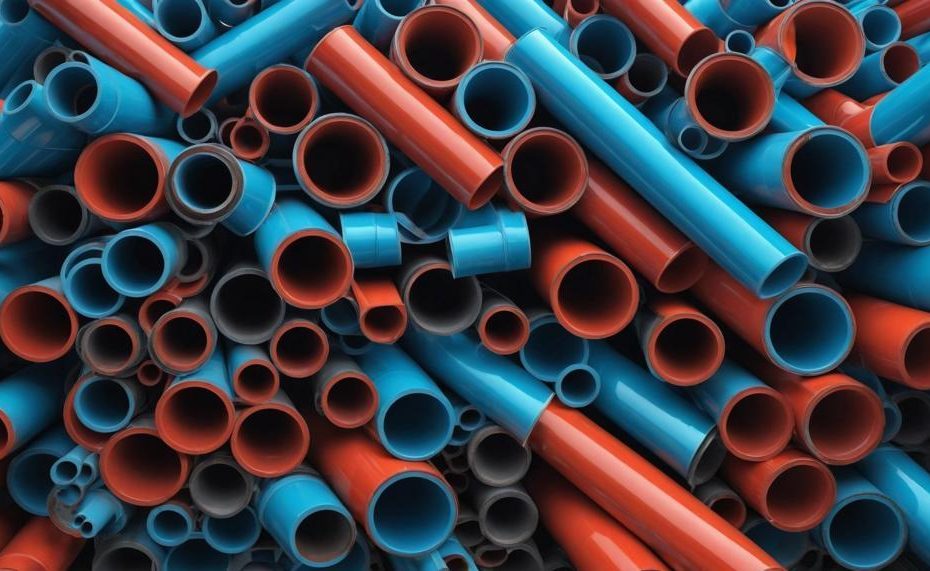Yes, ABS pipe can be connected to PVC. This might surprise some, but with the right tools and techniques, it’s entirely possible. In many homes, you might find half the sewer pipe is made of black ABS and the other half is white PVC, especially in under-sink plumbing. Though it’s uncommon, the need to connect these two different types of plastic pipes does arise, and understanding how to do it correctly is crucial for a smooth and leak-free plumbing system.
Here’s what you need to know:
- Transition Cement: For Drain-Waste-Vent (DWV) applications, using a transition cement designed specifically for bonding ABS to PVC is necessary. However, this is not suitable for pressure applications.
- Multipurpose Cements: These special cements can bond PVC, CPVC, and ABS pipes together and are available at most hardware stores.
- Rubber Couplings: Ideal for connecting unthreaded pipes of different diameters, these couplings provide a flexible and durable solution.
Key Takeaways:
- ABS and PVC can be connected with the right materials.
- Use transition cement for DWV applications, not for pressure systems.
- Multipurpose cements and rubber couplings are readily available and effective solutions.
Table of Contents [show]
How Can I Connect ABS to PVC?
Connecting ABS to PVC pipes can be achieved through several methods, each suited to specific applications and conditions. Below are the primary methods:
- Solvent Cement Method: This is the most common method for non-pressure applications like Drain-Waste-Vent (DWV) systems. Special transition cement is required, designed to bond both ABS and PVC. Here’s how you can do it:
- Cut the Pipes: Measure and cut both ABS and PVC pipes to the required lengths.
- Apply Primer and Cement: Apply a primer to the outside of the ABS pipe and the inside of the PVC pipe. Follow this by applying the transition cement.
- Insert and Hold: Insert the ABS pipe into the PVC coupling and hold them together for a few seconds to allow the cement to set.
- Mechanical Couplings: Mechanical couplings are versatile and can connect pipes of different materials and sizes. These couplings use rubber sleeves and steel clamps to create a tight seal.
- Cut and Prepare Pipes: Cut the pipes to the desired lengths and clean the ends.
- Insert Pipes into Coupling: Slide the coupling over the ends of both pipes.
- Tighten Clamps: Use a screwdriver or wrench to tighten the steel clamps around the coupling, ensuring a secure fit.
- Threaded Adapters: For smaller diameter pipes or specific fitting needs, threaded adapters can be used.
- Thread the Pipes: If not pre-threaded, use a pipe threader to create threads on the ends of the pipes.
- Apply Teflon Tape: Wrap Teflon tape around the threads to ensure a tight seal.
- Screw Adapters: Screw the threaded ABS and PVC adapters onto the respective pipes and then screw them together.
- Heat Fusion Welding: Though less common for ABS and PVC, this method involves using heat to fuse the pipe materials together. It requires specialized equipment and is typically used for industrial applications.
How Do I Install Transition Coupling?
To install a transition coupling between ABS and PVC pipes, follow these steps meticulously to ensure a secure and leak-proof connection:
Cut the Pipes
Measure and cut the ABS and PVC pipes to the desired length using a hacksaw or PVC cutter. Ensure the cuts are clean and straight to provide a good fit.
Prepare the Pipe Ends
Clean the ends of both pipes thoroughly. Remove any burrs or debris that could interfere with the coupling.
Apply Primer and Cement
For the PVC pipe, apply a primer to the outside of the pipe end and the inside of the coupling. This step is crucial as it cleans and softens the PVC, ensuring a strong bond.
Apply PVC cement to the primed areas on the PVC pipe and the coupling. Be generous but avoid excessive application to prevent drips inside the pipe.
Join the Pipes
Quickly insert the PVC pipe into the coupling while the cement is still wet. Twist the pipe slightly as you push it in to evenly distribute the cement.
Repeat the cement application process for the ABS pipe, but use ABS-specific cement. Insert the ABS pipe into the other end of the coupling and twist slightly for a proper bond.
Align and Secure
Ensure both pipes are aligned correctly within the coupling. Hold the pipes in place for a few seconds to allow the cement to set. Wipe off any excess cement from the outside of the joint.
Curing Time
Allow the joint to cure as per the cement manufacturer’s instructions. This usually takes around 24 hours to achieve full strength.
Tips for Successful Installation
- Clean the Pipes: Always clean the pipe ends thoroughly before applying cement to ensure a strong bond.
- Use Mechanical Couplings: Consider using mechanical transition couplings if you prefer not to use solvent cement. These couplings use gaskets to create a watertight seal and are easier to adjust.
- Proper Tools: Use a quality pipe cutter for clean cuts and a proper applicator brush for even cement application.
- Follow Instructions: Adhere strictly to the instructions provided by the cement and coupling manufacturers for best results.
Common Problems and Solutions
| Problem | Cause | Solution |
| Leaking Joints | Improper cement application or unclean pipe ends | Ensure thorough cleaning and proper cement application |
| Misaligned Pipes | Pipes not held in place while cement sets | Hold pipes for a few seconds after joining to allow cement to set |
| Weak Joint | Insufficient curing time | Allow proper curing time as per cement instructions |
What Is Transitioning Glue?
Transitioning glue, often referred to as transition cement or all-purpose cement, is specially formulated to bond dissimilar plastics like ABS (Acrylonitrile Butadiene Styrene) and PVC (Polyvinyl Chloride). Here’s how it works and why it is suitable for connecting these types of pipes:
How Transitioning Glue Works
Transitioning glue operates through a process called solvent welding. This involves a chemical reaction where the solvent in the adhesive dissolves the surfaces of both ABS and PVC pipes. This dissolution softens the plastic surfaces, allowing their molecules to intermingle.

When the solvent evaporates, the plastics harden and fuse into a single piece, creating a robust, leak-proof joint.
Suitability for ABS and PVC Pipes
The suitability of transitioning glue for connecting ABS and PVC pipes can be attributed to several factors:
- Chemical Compatibility: The adhesive is engineered to interact chemically with both ABS and PVC, ensuring a strong bond.
- Versatility: It works well under various conditions, making it ideal for different types of plumbing applications.
- Ease of Use: The glue is user-friendly, allowing for straightforward application and curing processes.
- Reliability: It provides a durable connection that can withstand the pressure and environmental factors common in plumbing systems.
Steps for Using Transitioning Glue
- Preparation: Clean and sand the ends of the pipes to remove any dirt, grease, or burrs. This ensures a smooth, clean surface for the adhesive to work effectively.
- Application: Apply the glue generously to both surfaces. Ensure even coverage for a solid bond.
- Joining: Press the pipes together firmly and hold them in place for a few seconds to allow the glue to set.
- Curing: Allow the joint to cure fully before subjecting it to any stress or pressure. This typically takes 24 hours.
Best Practices for Transitioning Glue
- Surface Preparation: Always clean and sand the pipe ends before applying the glue.
- Application Technique: Apply an even coat to both the pipe and the fitting for a secure bond.
- Curing Time: Give ample time for the glue to cure to ensure maximum strength.
- Inspection: Check the joint for any weak spots or gaps after curing.
What If I Use Transitioning Glue to Connect ABS and PVC Pipes by Accident?
Yes, it is possible to use transitioning glue to connect ABS and PVC pipes. However, there are significant potential consequences if this is done by accident.
Joint Failure
- Chemical Incompatibility: PVC glue, known as solvent cement, is chemically incompatible with ABS. This can cause the joint to fail.
- Leakage: Due to the weak bond, the joint may develop leaks, leading to potential water damage.
Thermal Expansion Issues
- Different Expansion Rates: ABS and PVC have different thermal expansion coefficients. This can lead to joint stress and eventual failure, especially in environments with temperature fluctuations.
Material Degradation
- Weak Bond: Even if the glue temporarily holds, the bond will degrade over time, causing long-term reliability issues.
What Is Purple Primer?
Purple primer is vital for connecting ABS and PVC pipes, ensuring a secure and durable bond. Here’s how it works:
- Surface Preparation: Purple primer cleans and softens the pipe surfaces, removing dirt, grease, and oils that can hinder adhesion. This step is crucial as it ensures that the solvent cement can penetrate the material effectively.
- Enhanced Bonding: By softening the surface, purple primer makes the material more receptive to the solvent cement. This creates a chemical weld between the pipes, which is essential for preventing leaks and ensuring the joint’s longevity.
- Ensures Compatibility: Given that ABS and PVC are not naturally compatible, using a primer specifically designed for these materials helps create a reliable connection. This preparation step is particularly important because the primer allows the solvent cement to work more effectively across different materials.
- Visual Indicator: The purple color of the primer acts as a visual indicator to ensure that the proper preparation has been done. This is especially useful in plumbing inspections, allowing for quick verification that the primer was applied.
Conclusion
Connecting ABS to PVC pipes can be done efficiently and securely with the right approach, ensuring your plumbing system remains reliable. Although these two types of plastic pipes are different, their connection is achievable using specific methods and materials.
First and foremost, for non-pressure applications like Drain-Waste-Vent (DWV) systems, transition cement is your go-to solution. This special cement is designed to bond ABS and PVC together. The process involves cutting the pipes to the desired length, applying a primer and transition cement, and then holding the pipes together to set.
Alternatively, mechanical couplings offer a versatile solution. These couplings use rubber sleeves and steel clamps to connect pipes of different materials and sizes. Simply cut and clean the pipe ends, slide the coupling over them, and tighten the clamps to secure the connection.
For smaller diameter pipes or specific fitting needs, threaded adapters are another viable option. Thread the pipes, apply Teflon tape to ensure a tight seal, and screw the adapters together.
Lastly, for industrial applications, heat fusion welding can be used, although it’s less common for ABS and PVC.






